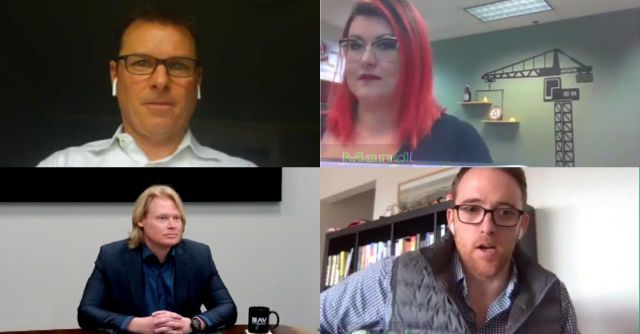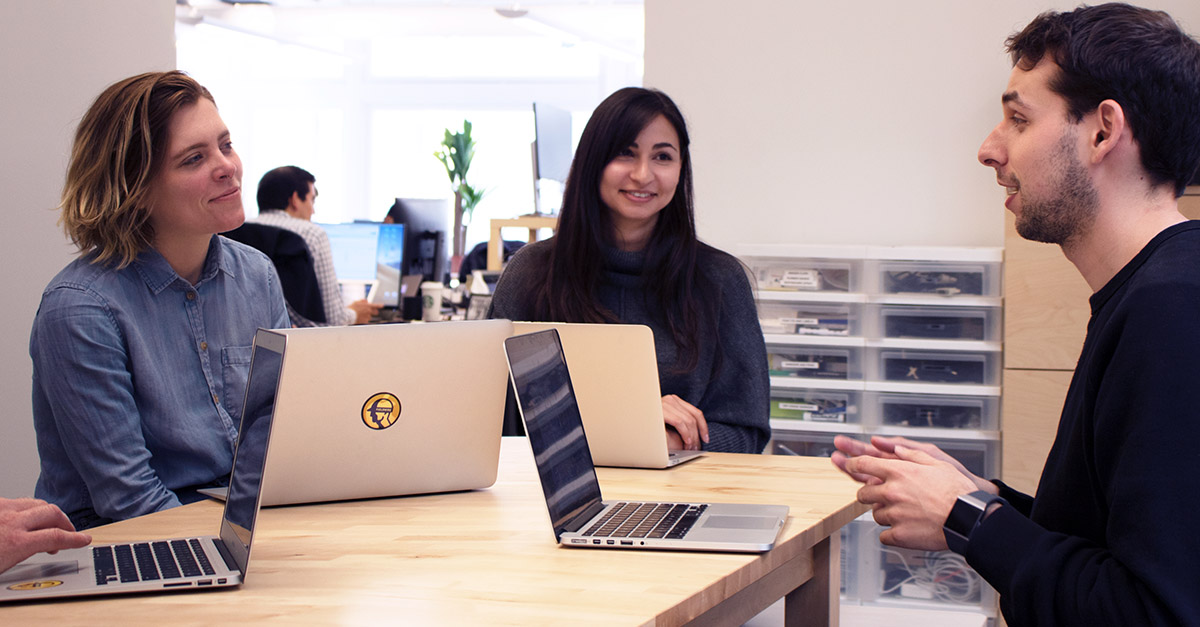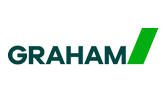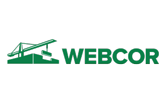Coronavirus & Construction: Town Hall Recap

For a lot of people, right now is about survival. If you’re a construction pro, you’re likely asking yourself, “How do I protect my employees’ health and finances -- and still keep our company afloat?”
We do not have the answers -- no one does. But we do have access to a community of construction professionals.
That's why we hosted a virtual town hall earlier today — for us to work together on solutions for this ongoing situation. It was an opportunity for us to talk about what's happening now and to figure out how to move forward.
Speakers
- Tim Pickett, President and Owner of Encompass AV, speaking to the concerns of subcontractors have about potential shutdowns
- J.D. Ahearn, Senior PM, XL Construction, talking about keeping his teams safe while working healthcare projects
- Mandi Kime, Director of Safety, AGC, Washington State Chapter, who has best practices for on-site safety during the pandemic
Listen to the webinar on Spotify or Apple Podcasts.
For a succinct summary, check out Construction Dive's coverage of the event.
Transcript
[Yves Frinault] Hi. My name is Yves. I am the Co-Founder and CEO of Fieldwire. We’re a construction start-up based in San Francisco. And like many of our guests today I am quarantined in the comfort of my home right now which is where I am taking this call.
I wanted to welcome all of you who are attending this virtual town hall meeting. The goal today obviously is to talk about the current COVID-19 pandemic, its direct impact on the construction industry, and what contractors around the country are doing to mitigate the risk or adapt proactively to this situation. We have gathered a fairly diverse group of panelists to present the variety of the industry and bring differentiated points of view to the situation. I am going to introduce you to our panelists. Going from the East Coast to the West Coast, let’s start with Tim.
Tim is the president of Encompass AV. He is also the founder of the company. They are a specialty contractor in Chicago, Illinois. Low-voltage contractors, they do build high-end audio/video systems for hotels, restaurants, or even educational facilities like the University of Chicago. Welcome, Tim.
[Tim Pickett] Thank you. Thank you. Yes. That’s pretty much me and what I do. You nailed it.
[Yves Frinault] Good. Travelling West, we’re going straight to J.D. who is a Senior Project Manager of XL Construction. If you’re not familiar, XL is a big GC headquartered in San Francisco with a large footprint in healthcare. And so J.D. brings both the point of view of construction of a general contractor as well as a specific understanding of what’s happening on the healthcare side of the market. Welcome J.D.
[J.D. Ahearn] Thank you.
[Yves Frinault] Glad to have you. And last but not least, we have Mandi who is the Director of Safety at the AGC in the State of Washington. And of course Mandi brings a broader overview of the market that she gathers through all the members of her chapter. Mandi, correct me if I am wrong, but I think you have about half GCs and half specialty contractors as members. And of those groups, about half union, half non-union.
[Mandi Kime] Yes, roughly.
[Yves Frinault] Good. Alright. We’re glad to have you as well, Mandi. Let’s not waste time and dive right in.
The way we’re organizing the discussion today is going to be in two parts. We have questions prepared for our guests and that’s what we’re going to do in the first part. While this is happening, feel free to submit additional questions on chat. We have Justine moderating these for us in the background and she will pick up those questions and organize them so that we can actually cover them in the second part. Good.
Going back to you, Tim, maybe, to start this. We have seen basically global city shutdowns like in Boston last week. What’s the situation in Illinois and in Chicago specifically, and how much work are you able to do right now?
[Tim Pickett] Most of our — it’s a “shelter-in-place” order, right? It’s the same as a lot of states have right now. It’s essential businesses only, which is not super clear. As a low-voltage subcontractor, from what we’ve been able to find out from the government, we are allowed to work right now, when we are allowed on construction sites.
But the problem being for us as a small company is we have a lot of construction jobs, but we also have a lot of retrofits in-office, upgrades in office spaces, hospitality work, restaurant work, getting TVs on in sports bars — all that stuff is gone. The only jobs we have right now are new construction. We have about two or three large new construction projects we are currently on, and then some minor stuff.
But we lost about 70% of our revenue, making money and ability, when the shelter-in-place order went into effect. That has been challenging, to say the least.
Obviously cash-flow is your number one concern. Prioritizing where you’re spending cash and how you’re spending cash. And then another big concern of ours is maintaining your employees’ security and making sure that they feel secure, that they have jobs, and that everything will continue on. These are some of the challenges we have and are facing and are trying to come up with solutions for.
[Yves Frinault] We had a quick chat last week. Do you feel like you’re getting extra clarity from city or government guidelines right now in terms of what’s going to happen in the next few weeks, or are you still in the same situation?
[Tim Pickett] No. I think the government is — we don’t really have any clarity. As far as what Illinois has been projecting, they just say, “Well, it’s at least until the 8th of April, could be until the 15th, and we don’t know.” I think I know why they’re doing it.
But I also think it’s hugely important for business in general, and for security — just over the big scope of this whole thing is just to say, “This is when we think things are going to come back to normal, or when we think businesses are going to open.” I think if the government could provide some sense of closure or an end of this thing, you’re going to see more security in the markets, you’ll see more cash flow, more investment, people getting back on this thing. We can shelter-in-place for a while but we need to know when this ends in order for everybody to have a good secure feeling, and to plan accordingly. So yes, I’m looking to the government to give us a lot more information than they’re currently giving us right now. That’s how we feel here at least, in Chicago.
[Yves Frinault] That makes a lot of sense. I think in the Bay Area our “shelter-in-place” was extended until April 17th or 19th, I’m not quite sure. Maybe that’s a good segue into J.D.
J.D., can you tell us a little bit more about the projects you’re working on and why they might have a different status from regular commercial projects?
[J.D. Ahearn] Yes. So all of the projects that I work in are healthcare. They have come out right away pretty immediately to say that all of our projects are essential projects. So we had to take stock and really jumped back all the way to the top. At first, there were protocols and plans put in place to get our jobs up and running. All of our healthcare projects were up and running within one to two days.
For us, it starts with making the sites safe, not only for our employees but for the community of people that we work with. By developing protocols and procedures right away and getting them out to our clients and trade partners, you create some security there. On a daily basis, I’m going through routines of having to call up companies and walk them through the things that we’re doing to make our job safe and even bringing in additional staff to go on projects and to wipe down and create clean paths for our people to get in. So it’s been a challenge because there’s been a lot of information out there and people show up to jobsites. We’ve locked down our jobsites where no visitors are going to be allowed, every day there’s a daily check-in where we have a whole list of questions and procedures to go through before anyone comes on the site. It’s made it very challenging, it has slowed down productivity, but at the same time it’s keeping things moving and the clients are happy about that.
[Yves Frinault] That makes a lot of sense. I am guessing because of the nature of the projects, being healthcare facilities, it’s very unlikely that California is going to try to shut down the process, but you talked a little bit about slowdowns related to additional COVID-19 related processes. Are you seeing any other slowdowns that could be related loosely to the epidemic, like logistics or man-power not showing up on-site or subcontractors not wanting to expose their employees?
[J.D. Ahearn] Yes, we have had both of those. All of our subcontractors have. Initially, when the whole thing happened, no one showed up to jobsites. Everyone kind of sent us letters saying, “We’re not showing up.” Then we had to re-engage our subcontractors again by giving procedures and showing that we are making the safety of the site first. And then we again put processes in place to go out to all of our vendors and, for instance, casework vendors. One of our major casework vendors completely shut their facility down and we lost a week’s worth of productivity. Thank goodness our upper management got involved and were able to get the facility back up and running. Again, all this stuff is delaying projects.
Part of it is, these are important clients, so you have to notify them. But then also we are taking the time to get the information on a daily basis. Say, “Hey, here’s what we’re doing to resolve that, and here’s how it’s affecting scheduled productivity, and potential cost impacts.” That’s huge part of what I am doing right now, everyday.
We also do a weekly company-wide check-in and most of the office-side is all working from home now. We’re getting through those challenges of making sure we’re all communicating, and keeping up to speed with what’s going on, and at the same time trying to be productive. I have two kids at home, so I am juggling homeschooling and trying to get on calls and, luckily, a lot of people I work with are in the same situation. When my three-year-old comes in and jumps on my shoulders in the middle of a call, everyone laughs. I think everyone is kind of embracing the position we’re in, but also everyone is trying to really help and get us through these tough times. It’s like Tim said, it’s hard not knowing when it’s going to end.
[Yves Frinault] I’m glad there is a silver lining, that we are all spending a lot more time with family right now. So that’s great.
Mandi, going over to you, what else comes to mind for members of your chapter right now? I am guessing some themes are emerging right now, what are you hearing through the grapevine?
[Mandi Kime] So I will start by saying that probably what is top-of-mind for all of our contractors in Washington is the fact that our governor issued new “shelter-in-place” guidelines as of 5:30 PM last night. As we’re all aware, this whole situation has been evolving by the minute. And I concur with Tim wholeheartedly in the sense that we don’t have a whole lot of information from the government to tell us exactly what to do and what’s expected.
As a result of that, AGC has taken some measures. The beauty of a membership organization like this and having people spread throughout the country is we are all tackling this together and we’re communicating. We’ve had other chapters of AGC come together and create field jobsite guidelines for how to protect your workforce from the virus as best as we know based on CDC, Department of Health, OSHA, and local jurisdictions. That document has been compiled and shared amongst multiple AGC chapters now, for the benefit of their members.
What we did is we took that, because we had project owners that we had coming to us saying, “We need something more than guidelines.” So we have worked to create a document that takes those guidelines and made it into a site-specific document for contractors to look at. “These are the hazards, these are the exposures we have on our jobs, and this is how we’re going to mitigate those.” It documents that but actually can be used as a communication piece for their workforce.
Weeks ago we actually put out a “Toolbox Talk” on just some basics from CDC and that went all over the place, as well. We are in the process of updating that to more current information that we’re hearing from CDC and others.
But I think that the real thing that we’re hearing from everyone and that I think Tim and J.D. both really nailed in their commentary, is the uncertainty. We all have uncertainty. Every one of us is facing that together. I have four kids at home and, thankfully, my husband and I make a pretty good team, and we’re balancing all of that. But the unique nature of all of that is that, as much as it is uncertain for all of us, we are all facing this together. Separately, but together.
That really brings to light another issue that we are having in construction which I think is critical for us to talk about and continue talking about it, and push to the forefront of this, which is protecting everyone’s mental health during this crisis. This uncertainty, this lack of information, this not knowing what our future looks like in a week, versus a month, versus a year, we are all facing that together. But different people are going to handle that differently.
One of the things that I would be remiss if I didn’t talk about is, we have been working on this issue of suicide prevention in construction for a number of years, but if you look at the construction industry as a whole, we have six times the national average suicide rate. If we add uncertainty to this in construction, “What does our future look like?” then we really do need to have those conversations in ways that we can help people. It’s not just trying to listen and be good support and be positive, and give the answers that we know and also give them access to resources, whether it’s your employee assistance program, whether you have other health tools to point them towards, so they can take charge of that piece of their world and where they’re at. And there are plenty of resources to do that, where folks can still be in the comfort of their own homes and still get help. It also gives people a sense of control of one domain of their life. Everything else may be kind of out of our norm, but it gives folks a sphere of control that they actually have control of. It’s a good thing, at times like this.
[Yves Frinault] That’s a very interesting point you’re making, to go beyond simply treating the symptoms and adapting to COVID-19 right now and trying to extend the help to the human side of companies. Is there one resource you can point people to, to specifically think about that issue right now?
[Mandi Kime] AGC Washington has an entire website dedicated to this from our webpage but there’s also preventconstructionsuicide.com. There are a bunch of different resources out there that you can link to either through our website or others.
I am actually in the process of assembling a whole toolkit of resources that are specific for these uncertain times that we can share as well. I would be happy for Fieldwire as well to get it out.
[Yves Frinault] We will try to share that on our LinkedIn page or something like that to make it available to everyone. Thanks for bringing up that point. I know that for us at Fieldwire we are completely remote right now, meaning that we don’t even get to see each other on-site every day. We are making a specific push to make sure we are checking in with people at least individually within teams to make sure that the social network continues to work.
Tim, going back to you. What are some of the immediate adjustments you have taken to keep work going at Encompass AV?
[Tim Pickett] First off, let me touch on a couple thoughts I had. Touching on your point about keeping in touch, I think it’s really important to not just do emails. I have been trying to call my employees individually, too. Especially my senior team and my office team. All of us that are under the shelter-in-place order, we can’t go to the jobsites. I did come into the office today, as you can see, but I am the only one here. I really think having that human touch, hearing somebody’s voice on the other end — I think that’s a big deal.
The other thing I wanted to say really quickly, J.D., going back to bringing your vendors and subcontractors back onto the jobsite. One thing I struggle with, one of the ethical things I kind of struggled with earlier this week... We have jobsites in Minnesota right now. Right? They aren’t shutting down, the virus isn’t nearly as bad there as it is here in Illinois. How do I, as an owner, balance telling four of my technicians they have to go there next week, even though there’s a shelter-in-place order here? The local government here is making it seem like it’s the end of the world, whether it is or not. I know it’s very serious, of course. Even I am to the point of where, how would I feel if I was being told I had to go work on a jobsite where there’s 250-to-350 people, and yet I can’t go to my health club. Why is one okay and the other is not? Why is my health only worth X but when there’s money involved... As an employee, why isn’t my health worth more? That’s a question. Well, it’s not really a question. How do I balance is something that I am struggling with as a business owner, too. Maybe you all have thoughts on that. Anyways, I am sorry to get off-topic, Yves.
[Yves Frinault] No, no. It’s very good. J.D, do you have thoughts?
[J.D. Ahearn] Yes, I think that’s a great point. I think that you have to... At XL, as a company and a business owner, the first thing we did was really stop. We can go back to processes of communication. We want to look out for our own employees. We want our subcontractors to engage us and by putting protocols in place that come from the CDC and also what you’re getting from the government in terms of cleanliness and making the job safe, and even when the workers get there, showing that those processes are in place and you’re going the extra step, build the trust that you want from your subcontractor community, right? It’s really interesting, too. We call our guys “trade partners,” not subcontractors, because we believe that we want to partner with our teams so that we create a safe environment. And we say, “Here’re the procedures,” and they show up, they feel safe. If they don’t, they can push back, and we will engage and do what we need to do to make it safe.
[Tim Pickett] That’s great. That’s a good answer. That’s a good balance. The two major jobsites that we’re working on right now — that’s something that we need to be at in the near future, I don’t think either of them, and they will remain nameless, of course, have really suggested anything like what you’ve just said to me to make me feel safe to send my guys out. They have zero plans in place.
[J.D. Ahearn] Yes. My guys at the top, the president of my company and the seniors, have drafted letters and sent them to us and said, “Here’s what we’re doing, send these out to your trade partners and clients so that they know where we’re coming from and the processes that we’re putting in place. It’s important to us.”
Half of the companies, or the portion of the company that is not in healthcare, are shutting down and the great thing is those guys are coming over to help us because we have reached out to our healthcare clients also and said, “Hey, do you need help with anything else?” Like setting up facilities, or any additional help getting places set up for testing.
Again, the whole company is embracing this, it’s not just the healthcare side, and they understand the importance of it. I struggle with it, having kids, and Mandi brought up a great point of having mental health and, boy, the whole fact that you’re at home and don’t have contact with people? It’s tough.
My VP of healthcare set up a weekly meeting that I just got off of this morning. There’s probably seventy people that called in just like this, just to check in. “What’s going on, how’s everything going?” And even a little storytime, people saying, “I get up and drive for thirty minutes just to create the same routine and feeling of driving to work.” I think those things are going to become more and more important as this drags on, because it feels like this is going to drag on.
[Tim Pickett] Yes, it does. Yves, do you still want me to answer your question?
[Yves Frinault] Please do. I was going to ask it again.
[Tim Pickett] My office staff, actually my senior staff that’s in the office because we work hand-in-hand every day, we have definitely been keeping in really good communication. As soon as I get up, by 7 AM I send an email out, and I follow up with every person individually, text, things we’re working on, things we want to accomplish. And then I follow up with phone calls.
Now for our tech staff that hasn’t really been able to work, we have been focusing on new certifications, we use a program called AVIXA, I don’t know if you’re familiar with it or not. It sets standards for the audio-visual world, and there’s different levels you can achieve, CTS being one of them, CTS-D and CTS-I being the other ones. We encourage our employees to use this time. Most of our guys are salaried so they’re getting paid right now to earn these accreditations because that makes us a more solid company. We’re turning this time around for training, for people as much as we can.
I am working with my marketing team and trying to figure out what the market looks like after all this. Because, even when this is over, it’s not going to be business as usual as before. There’s going to be changes, there’s going to be — people are going to want to work remotely probably more often, so how do we as an A/V company improve that experience for them and become a part of that? Because as an A/V company, the way we looked at it three weeks ago was — we’re providing audio-visual for groups of people, that’s our whole thing. Whether it’s a conference system, whether I am doing a sound system for a hotel lobby, or a restaurant, these are all places where people are coming together as a group and having that social experience. I feel like that experience is going to slow down, so we’re trying to figure out how we’re going to adapt and what technologies that we currently have and are working on still apply just in a different way in the future.
That’s what we’re doing with our marketing team, we’re looking at that, looking at what markets we want to tackle, what markets are going to be critical coming out of this, and I think the hospitality and the service industry is going to be a little bit weak for the year 2020, so we will be focusing on education, people that are going to have budgets that are set in place for a year or two, and they don’t live quarter-to-quarter. That’s what we’re doing.
[Yves Frinault] That makes a lot of sense. Once again, from older projections, we’re seeing right now this is expected to last, in an aggressive quarantine scenario, at the very least we’re not even hitting peak until the end of May, mid-June, from the curves we have been able to watch. I think this is going to last a bit longer, at least that’s the way we are looking at it at Fieldwire.
We talked about the human side, we talked about just spending time with training right now. We talked about spending time with project partners, because I think many of them are open to pulling together significantly. Whether they are owners, general contractors or trade partners.
If we can try and zoom in on the site itself right now, and maybe J.D. and Mandi, you guys are going to have more practical advice. How do we respect the CDC guidelines in a practical way? What are the top three practical measures you’ve seen taken that work on-site to make the trade partner feel safe, and at the same time just keeping the site running. From what I have seen, some GCs have changed their sequencing on-site to being really separate, what are you seeing?
[Mandi Kime] J.D., do you want to go or do you want me to field that first?
[J.D. Ahearn] Go ahead, Mandi.
[Mandi Kime] Awesome. So I will say, I can offer that some of the guidelines that were published on the AGC document on jobsite practices. What we are seeing is obviously as you mentioned, rotation. Rotating breaks and lunches so you don’t have everybody on break at the same time on top of each other. Trying to be thoughtful, even down to your materials storage. Where you’re placing all your materials, are you forcing a bottleneck somewhere on the project site where people have to get closer than they need to get and are you using whatever means as far as mechanical assists, etcetera to help the workers not have to be in each other’s “bubbles,” so to speak.
Another thing that we are seeing as a big ramp-up is servicing the restroom facilities, getting those serviced way more frequently. Where sometimes before, once a week was sufficient, but now in this time with these exposures, they’re getting serviced way more frequently, sometimes daily.
Also, having someone in charge and going over those frequently touched areas, getting them sanitized more regularly, those kinds of things. Those are the primary ways that we are seeing that happen.
And reminding folks through the process of toolbox talks. With toolbox talks, there also needs to be reduced numbers, so by breaking your toolbox talks groups into smaller numbers, you’re not forcing people to be closer than they need to be but you can also communicate reminders to people about handwashing, about their need for social distancing, about their need for staggering breaks and all that other stuff. As much as it’s a lifestyle adjustment for all of us, it’s what is necessary in present times.
[Yves Frinault] J.D., does that resonate with what you are deploying on site right now, or are you seeing other trends as well?
[J.D. Ahearn] We definitely have embraced a lot of those same things. We have also taken some staggering of trades, as we discussed, so they all have different start times. We have also set up a — everyone has to check-in at the beginning of the job, so we have actually lost a little productivity because we have taken the time every day to go through and check people in, talk to them, and make sure they — that people are feeling safe. Also, there’s kind of a guideline that you run through, “Have you had a temperature?” and all those kinds of things. We have also taken on more of our own guys out there to do more wiping down of areas, and really trying to engage people in the six-foot rule. We’re willing to slow down productivity to be safe. That’s one of the things that we went right to our clients and said, “We will keep going, we will keep moving, but we will lose some productivity.” It’s the cost of being safe and continuing work, so that’s very important. What we really feel is very important.
[Yves Frinault] I just want to make sure that I heard you correctly. Did you say you’re taking the temperature of every tradesperson that comes on site?
[J.D. Ahearn] I think we are in the process of getting thermometers to test everybody. I think we have some already, some sites are doing that. By CDC rules right now, I don’t think it’s mandatory. We are trying to do everything we can do, to again build trust. We are actually in the process of getting more of those temporal thermometers so everybody coming through can be tested. We also have our daily list of questions we ask the guys every day before they come onto the jobsite.
[Yves Frinault] Okay, good.
I want to take the opportunity to ask everybody who is listening to keep submitting questions. We are going to wrap up the initial phase of this soon, and we’re going to start going on to our audience questions.
The last subject I wanted to cover briefly, though, and we’re going to project ourselves here a little bit longer is we all know that construction is a cash-intensive activity. Let’s talk a little bit about the economic impact of an extended shutdown, or disturbance of the supply chain. For example, I know, Mandi, the AGC nationwide has taken a really strong stance to discourage shutting down construction primarily because of the concern that the contractors are not going to be able to make payroll-slash-stay alive for an extended period. Can you expand on a current activity that’s going on that front?
[Mandi Kime] Not on a national level. Obviously, I don’t work at our national office so I can’t really speak to you on the behind-the-scenes going on there. But as you are well aware, AGC is doing daily webinars to keep our industry updated. We have one going on today right after this is done and we’re continuing to monitor all those situations and respond to them.
As far as here in our chapter in Seattle, like I mentioned earlier, the governor put out new clarifications last night at 5:30 PM. Clarifications that I am sure are with the intent that we all know what we’re supposed to be doing or not doing and I think it raised as many questions as it tried to answer. We are still in the process of finding answers for that.
There’s a lot of other aspects of this process that are evolving such as worker leave, furloughs, and stuff like that. Professionals that are very experienced in this avenue, attorneys and HR professionals, are helping us find the answers so we can give the best advice possible. As I imagine, there’s a diverse set of employers in our state, and if you expand that globally — just the wide range of employers that we represent. It is hard to find answers that make it all make sense. We have to work together to get answers that will work for the majority but there’s still a lot of one-offs and situations that really do require very specific answers and so it’s really hard to give one answer to every contractor and say, “This is how we proceed.” It would be a disservice if we did that. It’s a delicate dance, trying to find the right answer, especially when we’re not getting as much clarity in the answers that we are getting from the government.
[Yves Frinault] That is fair.
Staying on the subject of government. Do we know if the state of Washington, or on the federal level, the government is doing anything to help contractors dealing with new structural issues right now in the form of low-interest business loans and things like that? Are there any talks of that nature going on right now?
[Mandi Kime] That I am aware of? No. I am not. Obviously as the Director of Safety, I am not on that side of the discussions, I’m out in the forefront of discussing worker safety. We want to protect as many jobs as we can.
As you are all aware, that’s a very difficult balance to maintain, especially as a safety professional. You want the workforce to go home safe and whole and healthy. But also protecting them and protecting their mental health and protecting their long-range life is protecting their jobs and that’s a very difficult balance. At what point does that break even with government orders?
[Yves Frinault] Good. Tim, maybe you have thoughts on that? Have you heard anything on the loan side? You’re probably tracking that much more closely than I would?
[Tim Pickett] In Illinois — they just opened up Illinois last week for some kind of SBA addendum. Loans, cash loans. Of course, that’s a 300-page document, much of it copied and pasted and it’s complicated to say the least. It’s just a sign-up right now, I don’t think they’re processing anything.
The city of Chicago said they’re setting aside one hundred million dollars for loans to small businesses for up to two million dollars each. Those numbers don’t even make sense — a hundred million dollars is a drop in the bucket in this thing.
Like we talked about before, subcontractors — they’re smaller businesses and they’re going to — you’re going to see subcontractors drop pretty quickly if this thing is extended out too long and if the government doesn’t help quickly. I think expediting the help is going to be the trick with government as it always is. I think by the time they get their act together it will be August or September which will help some people for sure. It’s better than nothing.
However, subcontractors live on the draws from the banks that are getting processed by the GCs that are coming from clients and they’re already 60-to-90 days behind getting paid from the time they had to go purchase the materials and they’ve done the work. So the subcontractors are really the end of the food chain as far as getting paid. It’s tough.
You’re going to see a lot of the smaller subcontractors fold and even the larger subcontractors will release a lot of people. They will have to cut a lot of jobs in order to maintain. I know we are trying to be as efficient as possible and just streamline, and we’re making difficult choices. Things to pay, things that are just going to have to wait in order to make sure my staff gets paid. Most importantly, my staff has security. I am not very hopeful as far as the government goes.
[Yves Frinault] Okay, that’s a fair point. J.D., is there any reaction to Tim, as far as that owners slash general contractors are trying to make sure that they are maybe processing payments faster to help their trade partners in this case that are dealing with cash flow issues?
[J.D. Ahearn] Well, in one sense they are — most of my healthcare clients, most of them are still running and moving, and so they’re actually still paying which is a good sign at least for our market sector.
But just like Tim is talking about, we have already reached out to our subcontractors to kind of feel out what that impact is going to be. I think the leadership within XL is evaluating what we’re going to need to be doing in order to be a part of the solution. It’s a work-in-progress right now.
I haven’t felt any contractors say, “My workers...” I have had a little bit of pushback saying, “Hey, we want our workers to be safe.” I think a little bit of that is to have them re-engaged quickly. We are in Week Two of this right now and so everyone is learning.
I know from my standpoint — I know when I go home to my neighborhood in San Francisco at eight o’clock at night, I have never seen it so empty. It’s scary. We definitely have a big concern about what happens in three or four months, or even three or four weeks, when people are not getting paychecks and all that.
[Tim Pickett] Yes. You’re in healthcare, and you’re still going. What about the jobsites that do get shut down? Now the subcontractors are always slow to get paid to begin with, we’re always at the end of the chain. Whatever cash that contractors do have, they’re going to burn through to keep their staff and stay open and all of a sudden — a month, two months down the road, “Hey, get back to work.” How do I go buy the materials at that point? Because I burned through all my cash to maintain.
No offense, you guys — not you guys, but you know what I mean. You in general. Work for thirty days, buy all the materials, submit an invoice, and then thirty-to-sixty days from that you’ll get your check. But you don’t have the cash to go out and buy the materials anymore. Because we have had this gap, this blip. This is something that’s going to need to be addressed for the health of a lot of people out there. Because subcontracting companies like myself, we are employing less than fifty people, it adds up. That’s a lot. It’s a lot of the workforce out there. If you can’t keep us healthy, it’s going to be bad two months from now.
[J.D. Ahearn] Yes, I agree. I think you’re spot-on and I think because the economy in the Bay Area is so good, there are small guys that have a lot of people working for them and they’re actually going to have a bigger burden and fall into bigger problems than some of the bigger subcontractors and trade partners who have been established and have been around for a while. That’s a valid concern, Tim.
[Yves Frinault] Good. I am glad that we are basically asking the real questions about this. About keeping the trades healthy on the sites and keeping the businesses healthy so they can go through this as well as possible.
This is the conclusion of the first part. We went a little bit over, so for the second part I am going to ask audience questions. I am going to try and direct them at only one of you at a time, so let’s keep these rapid-fire answers on these, please keep the answers short so we can get through as many of them as possible, in a very direct way.
Mandi, if an employee becomes ill with COVID-19 symptoms that are detected upon entry to the site such as a high fever, what do we do as a specialty contractor? Do we treat people as a workers’ comp case and send them to the legal office?
[Mandi Kime] That’s going to vary from state-to-state, depending on what your workers’ comp laws are and what each jurisdiction is. Washington is a monopolistic state and so our workers comp is run through the state and that’s not going to be the same as every other jurisdiction. So I can’t say universally across the board. But what I can say is, check in with your local jurisdiction. It’s not going to hurt to talk to your TPA and ask those questions and make sure that you’re getting the employee's health taken care of.
[Yves Frinault] Good.
Question for you, J.D.. As an online project, we’re extremely worried about the economic impact. On the material shortage side, and the inability to obtain raw materials like steel, stone, luxury finishes, and things like that. Any idea how you’re going to mitigate or prepare for that specifically?
[J.D. Ahearn] In current projects that are running, you just have to really go back to your suppliers and your trade partners and find out the status of where it is. And then moving forward, I think you’re going to have to start building those into how we build our schedules.
Right now, it’s an unknown and you’re going to have to build in some buffers and confirm stuff before you build and promise things. It’s a big unknown. We haven’t felt it a lot yet, but we’re preparing for it because we know it’s going to happen.
[Yves Frinault] That’s fair. These are complex subjects and I think even just talking about this brings on complex discussions.
In the spirit of going even deeper, Tim, how do you approach the liability side of having workers dispatched on-site with the shelter-in-place order in Illinois and in neighboring states where that might not be the case? Are you thinking of the liability side of that?
[Tim Pickett] Yes, like I said earlier it’s a tough thing because I have pressure from a GC to send workers out of state, but the workers at the same time are saying, “Wait a second, we’re supposed to stay home, there’s probably a reason for that.” And the other ethical implication — and Yves, I am going to tell you right now, I don’t have an answer for you. The other ethical implication of this is, what if one of my guys is sick? Because in my state there’s a heck of a lot more cases. We’re in Illinois, then you go up to Minnesota or Wisconsin, then go do a jobsite up there. It’s a really tough conundrum.
We sent out a company-wide email today setting best practices and standards for jobsite safety and procedures. I haven’t seen anything come back from general contractors we have been working with, as much as I would like. I would definitely like more information. Of course, I am not my project manager either so I think that’s on my PM and they may have more information than I do on that. I would definitely like to see more information on safety procedures and I want to make my guys feel safe. At the same time, this is just one of a dozen contracts we’re doing for a particular client this year, and I need to keep them happy too. There’s a balance to be had, and I am working on it.
[Yves Frinault] Yes. I think, once again, talking to partners and trying to work out those complex situations might be the best solution in most cases. I know it is super common for electrical trades to travel the country quite a bit because they’re in high demand right now. On the West Coast, I know we have electrical tradesmen fly in from the Midwest. Is that the case on your side J.D.? And have those travels been interrupted? I know it’s very difficult to have a crew that’s from other states over here.
[J.D. Ahearn] We haven’t. The answer is that it hasn’t really impacted us. Because we are in the boom out here, people that are out here travelled here and are locked in and working here. For us there's been a shortage of electricians for five years now. So we’re not feeling it like that.
We’re feeling it more in — COVID-19 hasn’t impacted that as much as just the need to have qualified and better electricians and trade partners. I don’t know if that’s what you’re looking for, but we haven’t seen that. In our specialty work, we don’t get a lot of travellers as much.
[Yves Frinault] Yes, okay. That makes sense. I think it varies, it’s dependent on the type of project. So I think we talked — Tim, you brought up the subject of volume. You’re seeing about 70% of short-term volume and we covered that fairly quickly.
J.D., you talked about productivity loss. How much are we talking about roughly? 10% productivity loss, or are we talking about 50%, or what?
[J.D. Ahearn] Right now I would say because of the initial shock, probably about 50%. But it’s starting to creep back up because of the confidence, that we’re getting a reliable work force again. People are showing up. For the first week we couldn’t get guys back out every day but now we’re getting back in the flow. I would say about 50% productivity.
[Yves Frinault] Wow, that’s pretty severe. We’re talking about — going back to the question of liability, and maybe that’s a question for you, Tim. J.D., as well. Is it typical to ask a general contractor to release their liability when they’re asking for you to send labor to their site? Is that something that is happening? Maybe Mandi, you can comment on that? Is that something you have seen, in the state of Washington?
[Tim Pickett] It’s not something I have seen or done yet. That’s for sure.
[J.D. Ahearn] Now for us, we have had good responses that seem to be limiting liability. I don’t think we have gotten to that point yet.
[Tim Pickett] That’s probably a conversation for four weeks from now, huh?
[Yves Frinault] We will be sure to reconvene at that point.
Mandi, do you have closing arguments? The, maybe, top one, two, three things that contractors should do to protect their workers? I think that’s maybe what we should finish this discussion on.
[Mandi Kime] Thank you. First of all, thanks for giving me air time to have these conversations. I think they’re really important.
I would say probably the first point that I would like to make is that it’s uncertain times for all. So we need to embrace that. We need to communicate that. We need to be sure that what we know we are sharing, allaying people’s fears by sharing fact — what we do know, instead of what we guess or worst-case-scenario.
Everybody’s minds already go to the worst-case-scenario, for the most part, so rather than feeding that, feed the things that are going right. Congratulate people for doing a good job, thank them for the job they are doing, especially those that are working extra to make sure that jobsites stay sanitized. That we’re doing our documentation, that we’re having our toolbox talks, making people feel seen and appreciated is important. It’s an important piece to the mental health aspect that I talked about earlier.
Share resources on mental health. Again, preventconstructionsuicide.com. It’s really very important.
There are a ton of resources that I am going to share. And again, remind people, not just for the workplace, not just for showing up if you are still working, but in all aspects, social distancing, wash your hands, use proper hygiene, avoid being places you don’t need to be. That’s the whole point right now.
I have an advanced age grandfather that’s living in California right now and when I spoke to him this weekend he said, “It’s great that they’re doing this, morning shopping hours for seniors.” But honestly if you are able to take that off of someone’s plate, if they don’t have to go out, they don’t have to be exposed if they’re in a vulnerable population or if they’re immunosuppressed, you know, take that out of their hands or use the technology available to you to get stuff delivered or what have you. I’m taking off my “at-work” hat, that’s something we all could do better at. Don’t be places you don’t have to be, respecting your own space and other people’s space, and those good hygiene habits are all really important.
[Yves Frinault] Good. I think that’s really good advice. So once again, let’s keep everybody safe, let’s pay attention to the human element of the equation as well in any situation. Let’s work together with partners. As an industry — I don’t think it’s always the case in construction, so let’s take this opportunity to do that. I think we will find more will than is typical to help each other solve problems.
I want to thank our panelists that have been phenomenal today for their quality content. Thanks Tim, thanks J.D., thanks Mandi. That was really good. I want to thank the audience as well for dialing in.
We are probably going to take the recording of this town hall meeting and put it on the company LinkedIn so you can look directly at my LinkedIn, Yves Frinault, CEO of Fieldwire. It’s going to be there. Any resources we have talked about we’re going to post there as well. As the situation develops — we’re only at Week Two of this — we’re going to try and do additional interviews to bring differentiated points of view on the situation that we can all learn from. That’s where we’re going to be posting all of that. Once again, thanks everyone and have a great Tuesday.

 Yves Frinault •
Yves Frinault • 















